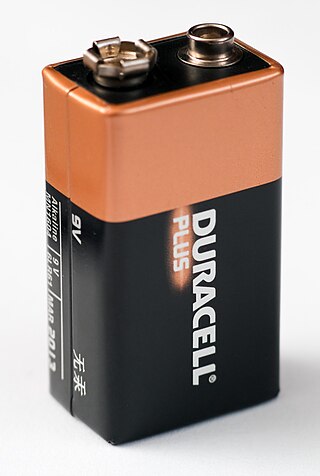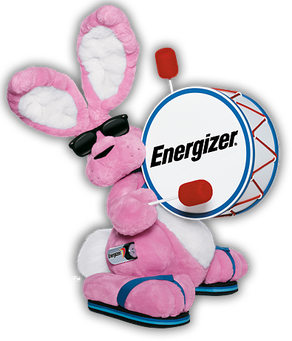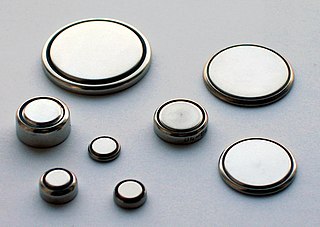
A nickel–metal hydride battery is a type of rechargeable battery. The chemical reaction at the positive electrode is similar to that of the nickel-cadmium cell (NiCd), with both using nickel oxide hydroxide (NiOOH). However, the negative electrodes use a hydrogen-absorbing alloy instead of cadmium. NiMH batteries can have two to three times the capacity of NiCd batteries of the same size, with significantly higher energy density, although only about half that of lithium-ion batteries.

Uniross is a brand with presence mainly in Europe & UK markets. Founded in 1968 in Bristol, UK it primarily deals in manufacturing of consumer & industrial batteries, chargers & lighting products.

Duracell Inc. is an American manufacturer of alkaline batteries, specialty cells, and rechargeables; it is a wholly owned subsidiary of Berkshire Hathaway. The company has its origins in the 1920s, through the work of Samuel Ruben and Philip Mallory, and the formation of the P. R. Mallory Company.
Eveready Battery Company, Inc. is an American manufacturer of electric battery brands Eveready and Energizer, owned by Energizer Holdings. Its headquarters are located in St. Louis, Missouri.

Energizer Holdings, Inc. is an American manufacturer and one of the world's largest manufacturers of batteries, headquartered in St. Louis, Missouri. It produces batteries under the Energizer, Ray-O-Vac, Varta, and Eveready brand names and formerly owned several personal care businesses until it separated that side of the business into a new company called Edgewell Personal Care in 2015.

An alkaline battery is a type of primary battery where the electrolyte has a pH value above 7. Typically these batteries derive energy from the reaction between zinc metal and manganese dioxide.

The Energizer Bunny is the marketing mascot of Energizer batteries in North America. It is a pink mechanical toy rabbit wearing sunglasses and blue and black striped flip-flops that beats a bass drum bearing the Energizer logo.

The Duracell Bunny is an anthropomorphic pink rabbit powered by Duracell batteries, and trademarked for use in all parts of the world except the United States and Canada. Advertisements, which may feature one Duracell Bunny, or several, usually feature the bunnies competing in some way; for example, in a game of football, a drumming competition or a race. In advertisements, the Duracell Bunny is either a standard battery-powered toy, a stop-motion puppet, or a CGI animated character.

The AA battery is a standard size single cell cylindrical dry battery. The IEC 60086 system calls the size R6, and ANSI C18 calls it 15. It is named UM-3 by JIS of Japan. Historically, it is known as D14, U12 – later U7, or HP7 in official documentation in the United Kingdom, or a pen cell.

A zinc–carbon battery (or carbon zinc battery in U.S. English) is a dry cell primary battery that provides direct electric current from the electrochemical reaction between zinc (Zn) and manganese dioxide (MnO2) in the presence of an ammonium chloride (NH4Cl) electrolyte. It produces a voltage of about 1.5 volts between the zinc anode, which is typically constructed as a cylindrical container for the battery cell, and a carbon rod surrounded by a compound with a higher Standard electrode potential (positive polarity), known as the cathode, that collects the current from the manganese dioxide electrode. The name "zinc-carbon" is slightly misleading as it implies that carbon is acting as the oxidizing agent rather than the manganese dioxide.
Telectronics Pty Ltd was an Australian company best known for its role in developing the pacemaker. It was located in Lane Cove, Sydney. In 1988 the business was acquired by Pacific Dunlop. However, legal claims resulting from the sale of faulty pacemaker electrode leads inherited by the company in acquisition of Cordis Corporation of Miami led to eventual sale of the assets of the company and Pacific Dunlop restructuring itself into Ansell.

A mercury battery is a non-rechargeable electrochemical battery, a primary cell. Mercury batteries use a reaction between mercuric oxide and zinc electrodes in an alkaline electrolyte. The voltage during discharge remains practically constant at 1.35 volts, and the capacity is much greater than that of a similarly sized zinc-carbon battery. Mercury batteries were used in the shape of button cells for watches, hearing aids, cameras and calculators, and in larger forms for other applications.

Eveready Industries India Ltd. (EIIL) is an Indian company that manufactures and markets batteries and lighting products. The Eveready brand has been present in India since 1905. It also manufactures photogravure plates, castings, carbon electrodes and related products.

A rechargeable alkaline battery, also known as alkaline rechargeable or rechargeable alkaline manganese (RAM), is a type of alkaline battery that is capable of recharging for repeated use. The formats include AAA, AA, C, D, and snap-on 9-volt batteries. Rechargeable alkaline batteries are manufactured fully charged and have the ability to hold their charge for years, longer than nickel-cadmium and nickel-metal hydride batteries, which self-discharge. Rechargeable alkaline batteries can have a high recharging efficiency and have less environmental impact than disposable cells.

A button cell, watch battery, or coin battery is a small single-cell battery shaped as a squat cylinder typically 5 to 25 mm in diameter and 1 to 6 mm high – resembling a button. Stainless steel usually forms the bottom body and positive terminal of the cell; insulated from it, the metallic top cap forms the negative terminal.
Philip Rogers Mallory was an American businessman and the founder of the company that is now known as Duracell International. Rather than making a career in his family's shipping business, he founded his own manufacturing company, the P. R. Mallory Company. Starting as a manufacturer of tungsten filament wire, his company later became The Mallory Battery Company and is now known as Duracell International.

The British Ever Ready Electrical Company (BEREC) was a British electrical firm formed in 1906 as the export branch of the American Eveready Battery Company. In 1914 it became independent of its American parent company.
The National Carbon Company was founded in 1886 by the former Brush Electric Company executive W. H. Lawrence, in association with Myron T. Herrick, James Parmelee, and Webb Hayes, son of U.S. President Rutherford B. Hayes, in Cleveland, Ohio. In 1890, National Carbon merged with Thomson-Houston, Standard Carbon, and Faraday Carbon.

An electric battery is a source of electric power consisting of one or more electrochemical cells with external connections for powering electrical devices. When a battery is supplying power, its positive terminal is the cathode and its negative terminal is the anode. The terminal marked negative is the source of electrons that will flow through an external electric circuit to the positive terminal. When a battery is connected to an external electric load, a redox reaction converts high-energy reactants to lower-energy products, and the free-energy difference is delivered to the external circuit as electrical energy. Historically the term "battery" specifically referred to a device composed of multiple cells; however, the usage has evolved to include devices composed of a single cell.

An N battery is a standard size of dry-cell battery. An N battery is cylindrical with electrical contacts on each end; the positive end has a bump on the top. The battery has a length of 30.2 mm (1.19 in) and a diameter of 12.0 mm (0.47 in), and is approximately three-fifths the length of a AA battery.
















